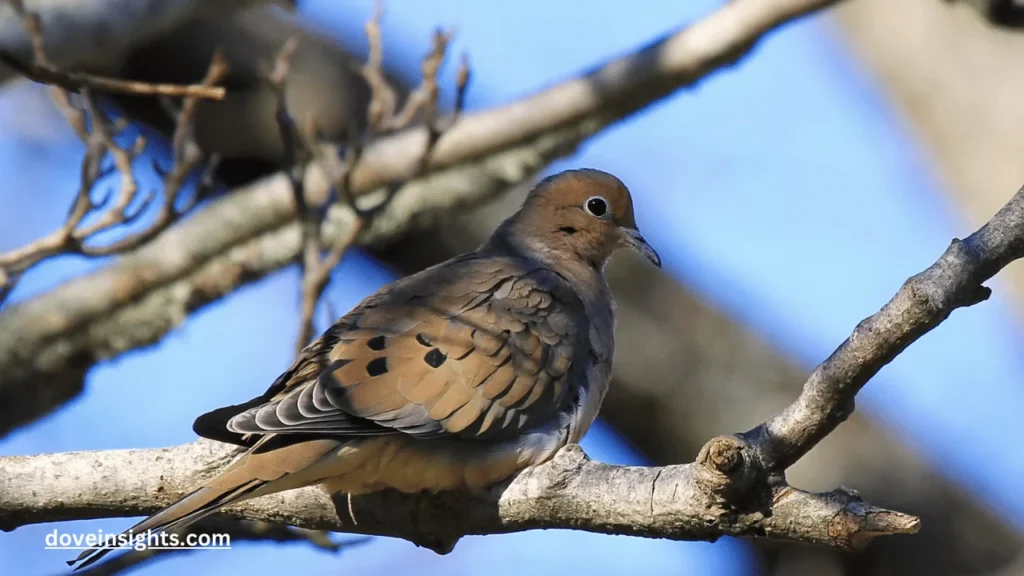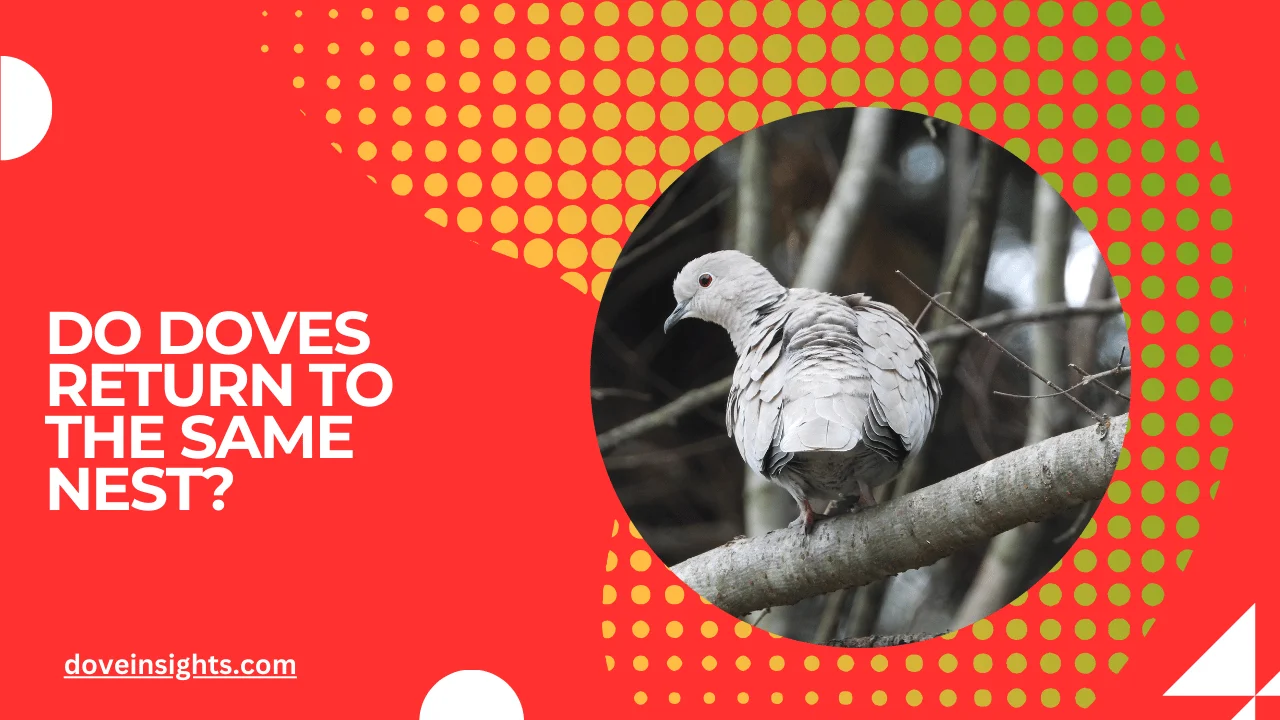Imagine you’re observing a pair of doves in your backyard, watching them as they build their delicate nest together in the branches of a tree.
The pair spends hours weaving twigs, grass, and leaves into a sturdy structure. As the days pass, they lay eggs, raise their chicks, and nurture their young. Once their babies are grown and leave the nest, it seems like the nest itself is abandoned—until next year. But then, unexpectedly, the same doves return to that exact same spot.
Do doves return to the same nest?
This question might seem simple at first, but the answer is more nuanced than you might think. Doves are known for their strong pair bonds, and their behaviors surrounding nesting are fascinating.
While doves are not creatures of habit in the same way some species are, they do have a unique approach to nesting that revolves around territory, seasonality, and availability of resources.
In this article, we’ll delve into the behavior of doves regarding their nests—how they choose where to nest, whether they return to the same nest year after year, and why this behavior is crucial for understanding their reproductive habits.
By the end of this article, you’ll have a clear picture of the nesting habits of doves and why some may return to the same spot, while others prefer to start anew each season.
Whether you’re a bird watcher, nature lover, or just curious about doves, this exploration will offer valuable insights into their nesting behaviors.
Contents
- 1 Doves’ Nesting Behavior: A Quick Overview
- 2 Do Doves Return to the Same Nest Year After Year?
- 3 Factors That Influence Dove Nesting Habits
- 4 Why Doves Don’t Always Return to the Same Nest
- 5 The Symbolic Significance of Dove Nesting Behavior
- 6 Conclusion
- 7 FAQ’s
- 7.0.1 Do doves return to the same nest year after year?
- 7.0.2 Why don’t doves use the same nest every year?
- 7.0.3 Do doves always return to the same nesting site?
- 7.0.4 Can doves use artificial nests or man-made structures?
- 7.0.5 How long do doves typically stay in their nests?
- 7.0.6 Do doves nest year-round?
Doves’ Nesting Behavior: A Quick Overview
Before we dive into whether doves return to the same nest, it’s important to first understand their nesting behavior. Doves are monogamous birds, meaning they form strong pair bonds that often last for a breeding season or even multiple seasons.
Unlike some species that form long-term monogamous partnerships, doves generally choose new mates each season, though they often return to the same areas to build nests.
Doves typically build their nests in trees, shrubs, or even on man-made structures such as rooftops, window ledges, or fences. They select sites that offer good protection from predators and are close to food and water sources.
The nests themselves are relatively simple, often constructed from twigs, leaves, and grasses. Both the male and female dove contribute to the building of the nest, but the female generally lays two eggs, which she and her mate take turns incubating.
The breeding season for doves is usually determined by environmental factors, such as weather conditions and the availability of resources.
Doves are particularly adaptable and can breed year-round in favorable climates, which means they may build several nests during a single year. But do they return to the same nest or simply build new ones each season?
Do Doves Return to the Same Nest Year After Year?
When it comes to whether doves return to the same nest, the answer is more complicated than a simple yes or no. Doves may return to the same nesting site, but not necessarily the same nest. While some birds, such as swans or eagles, are known to use the same nests year after year, doves typically do not.
The reasons for this are varied and involve both biological and environmental factors.
The nesting material used by doves, such as twigs and grasses, may degrade over time, making it difficult to reuse the same nest structure. Additionally, the nest may become infested with parasites or disease, which would make it an unsafe place for raising young.
For these reasons, doves often build new nests in the same location or nearby, preferring fresh materials for each breeding season.
However, some doves may return to the same area or tree, as they are familiar with the location and it provides a suitable environment for nesting. This indicates that territory is important for doves. While they may not use the exact same nest, they will often choose a similar site or even the same tree if it offers adequate shelter and safety for their young.
So, while it’s rare for doves to use the exact same nest, they do tend to return to the same nesting site.
Factors That Influence Dove Nesting Habits
Several factors contribute to whether doves return to the same nesting site or build a new one.
Availability of resources is one of the primary influences on dove nesting behavior. In areas where food and shelter are plentiful, doves may be more likely to return to the same general location, as it provides the necessary conditions for raising their young.
For example, if a pair of doves successfully raised chicks in a tree in a previous season, they may find it beneficial to return to that same tree or location the following year.
Another important factor is territory. Doves are known to be territorial during the breeding season. Males typically establish a territorial area where they court females and protect their nesting site. This territory can extend several meters around their nest, and males may defend the space from other males.
If the pair successfully raises their young in a given territory, they are likely to return to the same location in the following year, especially if the area remains safe and offers suitable nesting opportunities.
Environmental factors also play a role. Weather conditions, predation pressure, and seasonal changes may all impact a dove’s decision to return to the same nesting site.
For example, if a nesting site was disturbed by harsh weather or predators in the previous season, the doves may choose to build their nest in a new location.
Why Doves Don’t Always Return to the Same Nest
Although it’s common for doves to reuse nesting sites, they don’t typically return to the exact same nest for several reasons. First, as mentioned, the nest structure itself may not be durable enough to withstand a second use.
Doves build relatively fragile nests that are made of light materials like twigs and leaves. These nests deteriorate over time due to exposure to the elements, and once they’ve been used, the structure may no longer be safe or comfortable for raising new chicks.
Another reason doves don’t always return to the same nest is that they are vulnerable to parasites and disease. Nests can become infested with mites, lice, or fleas, which could harm the adult doves or their chicks.
To avoid these risks, doves prefer to construct new nests in fresh areas where there is less chance of encountering such problems. Cleanliness and hygiene are crucial to the survival of their young, and the health of the nest is just as important as its location.
Lastly, the overall safety of a nesting location influences a dove’s decision to return.
If a nest has been attacked by predators or disturbed by human activity, the doves may seek out a new, safer location to raise their next brood.
The Symbolic Significance of Dove Nesting Behavior

Doves are often symbolic of peace and love, and their nesting behavior reflects the themes of commitment and reliability.
While they may not return to the same nest, they return to the same territory, reinforcing their bond to the environment and their mate. The act of building a nest, whether new or reused, signifies a strong connection to family and the instinctual desire to protect and nurture their young.
For humans, watching doves engage in this cyclical pattern of nesting and raising young can be a powerful reminder of the cycles of life.
Their nesting behavior, while not as predictable as some other species, still carries the themes of perseverance and adaptability, as doves find ways to thrive in various environments. Whether or not they use the same nest year after year, doves show us the importance of resilience, new beginnings, and the strength of family bonds.
Conclusion
In conclusion, while doves may not return to the exact same nest every year, they often return to the same general territory or nesting site.
Their nesting behavior is influenced by a variety of factors, including availability of resources, territorial instincts, safety, and the condition of the nest itself. Doves are opportunistic and adaptable creatures, capable of adjusting to changing conditions, but they maintain a deep connection to the areas they choose to nest in.
This adaptability in their nesting habits is a reminder of the resilience and commitment that doves symbolize, whether in nature or in our lives.
By understanding these fascinating aspects of dove behavior, we gain a greater appreciation for their role in the ecosystem and the natural world around us. Whether they return to the same nest or build anew, doves continue to inspire us with their enduring bonds and their capacity to adapt.
FAQ’s
Do doves return to the same nest year after year?
While doves do not typically return to the exact same nest, they often choose to nest in the same location or territory year after year. They may build a new nest in the same area because the site offers suitable conditions for breeding, such as safety, food, and shelter. However, nest reuse is uncommon due to the nest’s fragile structure and the potential for parasite infestation.
Why don’t doves use the same nest every year?
Doves generally do not reuse the same nest because nest materials, like twigs and leaves, degrade over time. The nest becomes less secure for the next breeding season, and the risk of parasites or disease increases, making it an unsafe environment for the next generation. For their health and the safety of their young, doves build fresh nests each season.
Do doves always return to the same nesting site?
Doves often return to the same general area or territory to nest, especially if the environment provides necessary resources like food and protection from predators. However, they may choose a different spot within the territory if their preferred location is disturbed, unsuitable, or destroyed.
Can doves use artificial nests or man-made structures?
Yes, doves are known to nest in artificial structures, such as window ledges, rooftops, balconies, and even barns. If these locations provide shelter and a suitable place for nest building, doves will often return to them, especially if they have successfully raised chicks in those spots before. Man-made structures offer safety from predators and a stable environment.
How long do doves typically stay in their nests?
Doves usually stay in their nests for around two weeks to incubate their eggs. After hatching, the chicks stay in the nest for another 10 to 15 days before they fledge and leave the nest. The exact duration may vary depending on environmental conditions and the health of the chicks.
Do doves nest year-round?
Doves can breed and build nests year-round, especially in warmer climates where food and shelter are consistently available. In areas with seasonal changes, doves typically breed in the spring and summer, building nests when temperatures are favorable and resources are abundant. However, in urban environments with constant food access, they may continue nesting through the cooler months.








